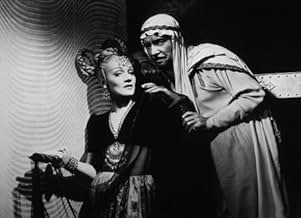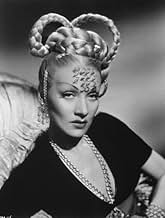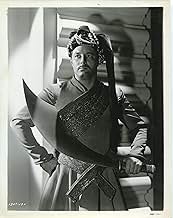AVALIAÇÃO DA IMDb
6,0/10
1,4 mil
SUA AVALIAÇÃO
Adicionar um enredo no seu idiomaIn ancient Baghdad, Hafiz the King of Beggars dreams of untold riches and of marrying his daughter to a real prince.In ancient Baghdad, Hafiz the King of Beggars dreams of untold riches and of marrying his daughter to a real prince.In ancient Baghdad, Hafiz the King of Beggars dreams of untold riches and of marrying his daughter to a real prince.
- Direção
- Roteiristas
- Artistas
- Indicado a 4 Oscars
- 1 vitória e 4 indicações no total
Eddie Abdo
- Aide to Mansur
- (não creditado)
- …
Jimmy Ames
- Major Domo
- (não creditado)
Morris Ankrum
- The Caliph's Messenger
- (não creditado)
Leslie Anthony
- Handmaiden
- (não creditado)
Lynn Arlen
- Handmaiden
- (não creditado)
Noble Blake
- Nubian Slave
- (não creditado)
Carla Boehm
- Handmaiden
- (não creditado)
Dick Botiller
- Aide to Mansur
- (não creditado)
- Direção
- Roteiristas
- Elenco e equipe completos
- Produção, bilheteria e muito mais no IMDbPro
Avaliações em destaque
'Kismet' marked Marlene Dietrich's final concession to Hollywood frivolity before getting into uniform for the sake of war work in Europe by appearing in Metro's version of the sort of Technicolor nonsense Maria Montez was currently making for Universal; albeit with a much starrier cast.
An Arabian Nights fantasy of the type being made back in Germany when William Dieterle was there directing silents (including a couple featuring Dietrich) with remarkably similar production design. Despite Ronald Colman's usual quiet authority in the lead, its most memorable feature has to be Dietrich performing - in the only one of her four scenes lasting longer than a minute - an exotic 'dance' with - as Elkan Allan once described it - "that fabulous body painted gold", owing more to editing than choreography and anticipating Shirley Eaton in 'Goldfinger' by twenty years.
An Arabian Nights fantasy of the type being made back in Germany when William Dieterle was there directing silents (including a couple featuring Dietrich) with remarkably similar production design. Despite Ronald Colman's usual quiet authority in the lead, its most memorable feature has to be Dietrich performing - in the only one of her four scenes lasting longer than a minute - an exotic 'dance' with - as Elkan Allan once described it - "that fabulous body painted gold", owing more to editing than choreography and anticipating Shirley Eaton in 'Goldfinger' by twenty years.
To be bothered by he fact that all the principals of this movies were Western is to miss the point. This is a document of a given time and place (Hollywood in 1944). Ronald Coleman was born to play the part of the poetic beggar prince. Who could be better to declaim the bits of Omar Khayam in the script. It's a little like his take on Francois Villon in "If I Were King". Marlene Dietrich is magnificent as a Macedonian princess in the Grand Vizier's harem. She does a beautiful and seductive dance. Edward Arnold supplies real menace as the heavy just as he did in "Meet John Doe". The whole premise of a movie like this is naive and unhistorical but the production was so ambitious and sumptuous that it transcends that shortcoming.
I've always felt that the technicolor used in the 1940s constituted some of the best color photography ever seen on film. KISMET is no exception. The color is ravishing, with pastel hues for the sets and costumes in interior scenes and ranks with the best color cinematography of any of the '40s films.
Unfortunately, the vehicle itself is weak and Ronald Colman is not the most suitable choice for the role of the scheming beggar. I admire Colman and he uses his speaking voice to marvelous effect but it's hard to see any chemistry between him and Marlene Dietrich, nor does he seem agile enough in the role. She plays the seductive charmer with all of the glamour she is noted for, including a sensuous dance with her famous gams painted gold. Too bad she wasn't given more screen time since hers is the film's most interesting performance.
James Craig had some decent roles in the '40s but here he is totally bland and colorless as the prince that Colman's daughter is in love with--only she knows him as a common gardener. The improbable plot is a thin one but made bearable by the exquisite photography, busy musical background score and some good character actors. Edward Arnold has a major villainous supporting role and seems to be thoroughly enjoying himself.
In my opinion, the '55 musical remake with Howard Keel in the Colman part showed us just how good the role of the beggar could have been if Colman played it more tongue-in-cheek. Keel was more physically right for the role, as well. Unfortunately, Colman always looked on the verge of middle-age in most of his roles, no matter how early the films were!
Trivia: this KISMET was nominated for four Academy Awards: color cinematography, art direction, background score and sound recording. If the Best Costume category had been recognized then, it no doubt would have been nominated in that category too.
Unfortunately, the vehicle itself is weak and Ronald Colman is not the most suitable choice for the role of the scheming beggar. I admire Colman and he uses his speaking voice to marvelous effect but it's hard to see any chemistry between him and Marlene Dietrich, nor does he seem agile enough in the role. She plays the seductive charmer with all of the glamour she is noted for, including a sensuous dance with her famous gams painted gold. Too bad she wasn't given more screen time since hers is the film's most interesting performance.
James Craig had some decent roles in the '40s but here he is totally bland and colorless as the prince that Colman's daughter is in love with--only she knows him as a common gardener. The improbable plot is a thin one but made bearable by the exquisite photography, busy musical background score and some good character actors. Edward Arnold has a major villainous supporting role and seems to be thoroughly enjoying himself.
In my opinion, the '55 musical remake with Howard Keel in the Colman part showed us just how good the role of the beggar could have been if Colman played it more tongue-in-cheek. Keel was more physically right for the role, as well. Unfortunately, Colman always looked on the verge of middle-age in most of his roles, no matter how early the films were!
Trivia: this KISMET was nominated for four Academy Awards: color cinematography, art direction, background score and sound recording. If the Best Costume category had been recognized then, it no doubt would have been nominated in that category too.
10Molly-31
William Dieterle directing, music by Harold Arlen (there's even a tiny bit of the Witch's Guard music at one point!), opulent sets and gorgeous costumes, Ronald Colman -- what more could anyone ask?
The film was very carefully crafted. Even the bit players -- especially Henry Davenport and Florence Bates -- were perfect. From the beginning, you are immersed in a magical world, an Iraq that died long ago, the Islam of Arabian Nights and Haroun el-Raschid, a romantic culture with its own philosophies and mysteries. Karsha foretelling the future with a sand reading, the muezzin and his apprentice singing the call to prayer, or the public bathing place that the rascals hide in, give the film a sense not only of unity and atmosphere but of meticulous attention to detail.
Dietrich's character was not Greek but Macedonian (like Alexander the Great, another blonde). I could have stood for more authenticity in her dance (especially after the Kraft girls who preceded her -- their Deva Dasi style dance *was* pretty authentic) and that gold paint was a little much. Still, the idea was that Jamilla was wild, and did unconventional things.
I do see where it could have been better. Craig in particular sounds jarringly "modern". But you forget that after a while. Modern films don't present this kind of idealism. We have to have everything brought down to sordid reality. A thing like this is good for you after too much "realism" gunk.
The film was very carefully crafted. Even the bit players -- especially Henry Davenport and Florence Bates -- were perfect. From the beginning, you are immersed in a magical world, an Iraq that died long ago, the Islam of Arabian Nights and Haroun el-Raschid, a romantic culture with its own philosophies and mysteries. Karsha foretelling the future with a sand reading, the muezzin and his apprentice singing the call to prayer, or the public bathing place that the rascals hide in, give the film a sense not only of unity and atmosphere but of meticulous attention to detail.
Dietrich's character was not Greek but Macedonian (like Alexander the Great, another blonde). I could have stood for more authenticity in her dance (especially after the Kraft girls who preceded her -- their Deva Dasi style dance *was* pretty authentic) and that gold paint was a little much. Still, the idea was that Jamilla was wild, and did unconventional things.
I do see where it could have been better. Craig in particular sounds jarringly "modern". But you forget that after a while. Modern films don't present this kind of idealism. We have to have everything brought down to sordid reality. A thing like this is good for you after too much "realism" gunk.
Third movie version of popular story involving beggar/magician in Bagdad who impersonates a prince. Meanwhile, the beggar's daughter falls for a camel-boy who's really a prince in disguise! Somehow, Marlene Dietrich gets shoehorned in playing sheltered royalty who rebels by doing a hot dance routine which must've been pretty risqué for 1944 (she's slathered in gold paint). MGM adventure does a nice job rewriting the original play by Edward Knoblock, featuring a colorful production and welcome comedic elements. It's jaunty fun with a fairly fast pace, hindered only by Ronald Coleman's miscasting in the lead (and his surprising lack of chemistry opposite Dietrich). Nominated for four Oscars, including Charles Rosher for his cinematography. Remade as a musical in 1955. **1/2 from ****
Você sabia?
- CuriosidadesThe decision to paint Dietrich's legs gold was a last resort. Initially, they had made fine mesh tights for her, like chain-mail. It took several hours to close the links up the back using jeweler's pliers. However, after she was encased in the mesh, it was discovered she couldn't move, so they undid the tights and resorted to gold paint.
- Erros de gravaçãoRonald Colman's character eats with his left hand, which is taboo in Arabic culture.
- ConexõesFeatured in Quando Hollywood Dança (1985)
- Trilhas sonorasTell Me, Tell Me, Evening Star
(1944) (uncredited)
Music by Harold Arlen
Lyrics by E.Y. Harburg
Partially sung by Marlene Dietrich
Sung by Joy Page (dubbed by Doreen Tryden)
Principais escolhas
Faça login para avaliar e ver a lista de recomendações personalizadas
- How long is Kismet?Fornecido pela Alexa
Detalhes
- Data de lançamento
- País de origem
- Idioma
- Também conhecido como
- Oriental Dream
- Locações de filme
- Empresa de produção
- Consulte mais créditos da empresa na IMDbPro
Bilheteria
- Orçamento
- US$ 3.000.000 (estimativa)
- Tempo de duração1 hora 40 minutos
- Proporção
- 1.37 : 1
Contribua para esta página
Sugerir uma alteração ou adicionar conteúdo ausente


































